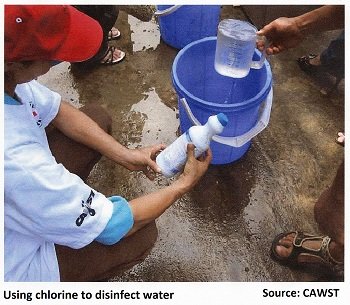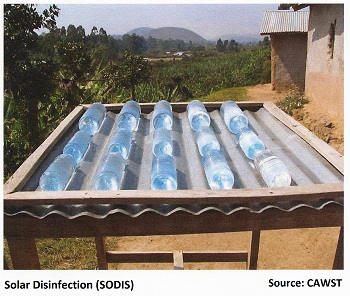Disinfecting Water is an Important Part of the Multi-Step Process of Household Water Treatment and Storage
Disinfecting water kills coliform bacteria and other disease-causing pathogens.
Note: The content on this page has been adapted from publications of World Health Organization (WHO) and Centre for Affordable Water and Sanitation Technology (CAWST).

Three of these methods of disinfecting water are
Chlorine Disinfection,
Boiling, and
Disinfection by Solar Radiation (SODIS).
How Does Chlorine Disinfection Work?
Chlorine is a popular chemical used to disinfect drinking water. Sodium hypochlorite and NaDCC, also known as sodium dichloroisocyanurate or sodium troclosene, are different types of chlorine that are available.

There are several different brands of chlorine products that have been manufactured specifically for household water treatment. Each product should have instructions explaining how to use it properly.
Effectiveness
* Quality: Very effective in removing bacteria; not effective for certain types of protozoa; protects water against recontamination
* Quantity: Depends on the size of container being used
* Local water: Should only be used with clear water; may need to sediment and filter water before using chlorine
Appropriateness
* Local availability: Available for purchase in most places
* Time: Need to wait at least 30 minutes after adding chlorine
* Operation and maintenance: Follow manufacturer's instructions for specific products; store chlorine away from children
* Lifespan: Up to 5 years for tablets; liquid chlorine products should used within 3 months of being manufactured
Acceptability
* Taste, smell, and color: Some people do not like the taste or smell of chlorinated water; does not change the color
* Ease of use: Follow manufacturer's instructions for specific products
Cost
* Initial purchase cost: None
* Operating cost: On-going cost to buy chlorine products; US$3/year
How Does Boiling Work?
Boiling is considered the world's oldest, most common, and one of the most effective methods for disinfecting water. Pathogens are killed when the temperature reaches 100 degrees Celsius.
CAWST recommends boiling water for 1 minute and adding 1 minute per 1000 meters of elevation.
Effectiveness
* Quality: Very effective in killing all pathogens
* Quantity: Depends on the size of pot being used
* Local water: Can be used with any water source
Appropriateness
* Local availability: Different fuel sources may be locally available (e.g. wood, charcoal, biomass, biogas, kerosene, propane, solar panels, electricity)
* Time: Need to heat water until it boils for 1 minute
* Operation and maintenance: Water is heated over a fire or stove until it boils; potential for burn injuries; cause of respiratory infections associated with poor indoor air quality
* Lifespan: Pots and stove may need to be replaced
Acceptability
* Taste, smell. color: Some people believe that boiled water tastes flat; does not change smell or color
* Ease of use: It may take a lot of time to collect enough fuel
Cost
* Initial purchase cost: Free or low cost since households can use existing pots
* Operating cost: On-going cost for fuel; cost varies depending on the type of fuel
How Does SODIS Work?
SODIS uses the rays from the sun to kill pathogens in the water. It can be used for disinfecting water in small quantities with low turbidity.

Households fill transparent, non-colored plastic bottles made from polyethylene terephthalate (PET) and place them in direct sunlight.
Water can be used directly from the bottle to avoid recontamination.
Effectiveness
* Quality: Effective in removing pathogens; provides safe storage to prevent recontamination
* Quantity: 1-2 liters/bottle
* Local water: Should only be used with clear water; may need to sediment and filter water before using SODIS
Appropriateness
* Local availability: Plastic bottles are available in most places
* Time: 6 hours on a sunny day; up to 2 days when cloudy; cannot use when raining
* Operation and maintenance: Simple
* Lifespan: Bottles need to be replaced if they have a lot of scratches
Acceptability
* Taste, smell, color: People do not like to drink warm water; does not change smell or color
* Ease of use: Easy
Cost
* Initial purchase cost: Free or low cost since households can use recycled plastic bottles
* Operating cost: None
Return to "Water Treatment" from "Disinfecting Water"
Return "Home"









